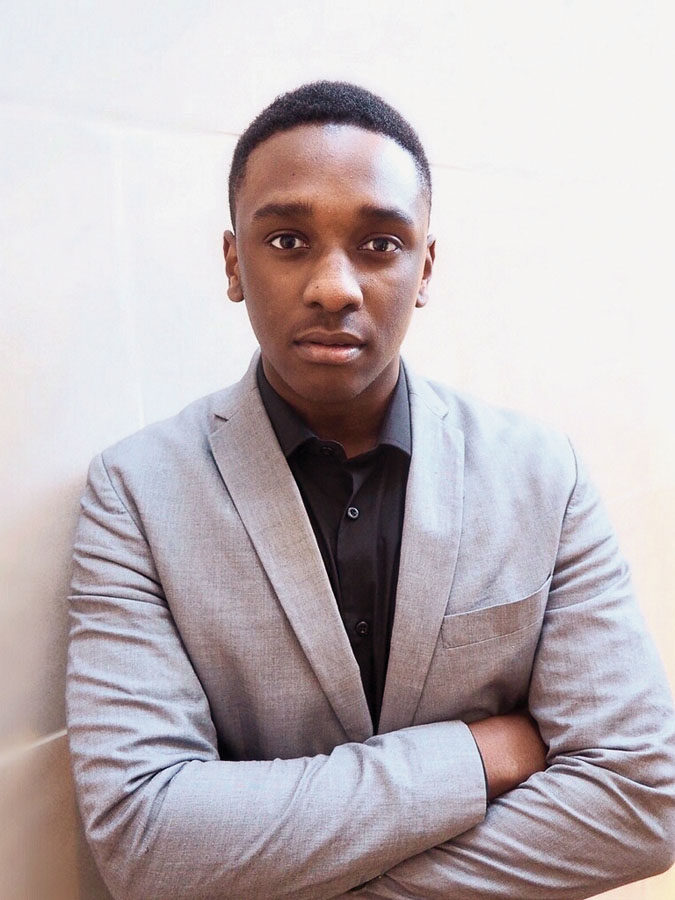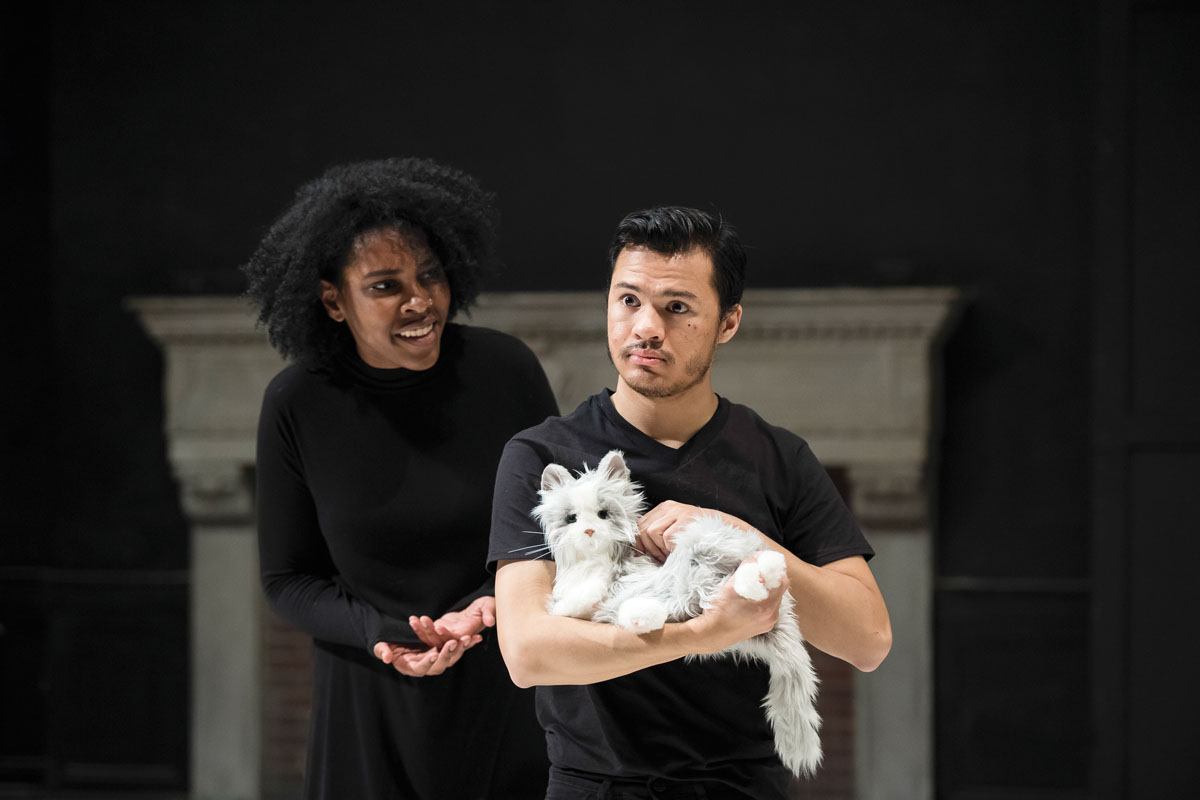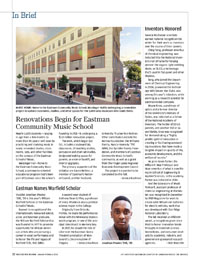In Review
 MUSIC HOME: Home to the Eastman Community Music School, Messinger Hall is undergoing a renovation project to update classrooms,
studios, and other spaces for the 1,600 area musicians who study there. (Photo: HBT Architects)
MUSIC HOME: Home to the Eastman Community Music School, Messinger Hall is undergoing a renovation project to update classrooms,
studios, and other spaces for the 1,600 area musicians who study there. (Photo: HBT Architects)Nearly 1,600 students—ranging in age from a few months to more than 90 years—will soon be practicing and studying music in newly renovated studios, classrooms, labs, and other facilities on the campus of the Eastman School of Music.
Messinger Hall—home to the Eastman Community Music School, a community-oriented educational program that’s been part of Eastman since the school’s founding in 1921—is undergoing a $2.8 million renovation project.
The work, which began last fall, includes a keyboard lab, classrooms, 24 teaching studios, percussion and drum set studios, designated waiting spaces for parents, an exterior facelift, and interior upgrades.
The primary supporters of the initiative are Karen Rettner, a member of Eastman’s National Council, and her husband, University Trustee Ron Rettner. Other contributors include the Kenlou Foundation, the Williams Family, Nancie Kennedy ’79E (MM), the Spindler Family Foundation, and members of Eastman Community Music School’s community, as well as a grant from the Finger Lakes Regional Economic Development Council.
The project is expected to be completed by this fall. —Jessica Kaufman
Eastman Names Warfield Scholar
 Jonathan Rhodes ’20E, ’20 (Photo: Courtesy of Johnathan Rhodes ’20E)
Jonathan Rhodes ’20E, ’20 (Photo: Courtesy of Johnathan Rhodes ’20E)Vocalist Jonathan Rhodes ’20E, ’20 is this year’s William Warfield Scholar at the Eastman School of Music.
Named in recognition of the internationally renowned soloist, actor, and Eastman graduate, the William Warfield Scholarship was founded in 1977 to promote opportunity for African-American artists who are pursuing a career in vocal performance and to honor the life and legacy of Warfield ’42E, ’46E (MM).
A second-year student of Anthony Dean Griffey, a professor of voice, Rhodes is also a political science major in the College.
Originally from Orlando, Florida, he made his performance debut with the Minnesota Opera’s youth program, in one of the principal roles (Kurz) in Memory Boy.
In 2017, he played the role of Liberto in the Eastman Opera Theatre’s production of Monteverdi’s L’Incoronazione di Poppea. —Jessica Kaufman
Inventors Honored
Several Rochester scientists earned national recognition this winter for their work as inventors over the course of their careers.
Ching Tang, professor emeritus of chemical engineering, was inducted into the National Inventors Hall of Fame for helping pioneer the organic light-emitting diode, or OLED, a technology that’s used in flat-panel and other displays.
Tang, who joined the Department of Chemical Engineering in 2006, pioneered the technology with Steven Van Slyke, also among this year’s inductees, while working as a research scientist for Eastman Kodak Company.
Wayne Knox, a professor of optics and a former director of the University’s Institute of Optics, was inducted as a fellow of the National Academy of Inventors. The holder of 50 US patents, and another 150 or so worldwide, Knox was recognized for demonstrating a “highly prolific spirit of innovation in creating or facilitating outstanding inventions that have made a tangible impact on quality of life, economic development, and the welfare of society.”
He joins Kevin Parker, the William F. May Professor and dean emeritus of what is now the Hajim School of Engineering & Applied Sciences, in the academy. Parker was inducted in 2016.
And the laboratory of Wyatt Tenhaeff, assistant professor of chemical engineering at Rochester, was recognized in December by R&D Magazine for work to create safer lithium-ion batteries for electric vehicles, work that was developed with Oak Ridge National Laboratory.
The lab received an R&D100 award, a recognition given since 1963 to honor innovative breakthroughs in materials science, biomedicine, and consumer products by academia, industry, and government-sponsored research agencies. —Bob Marcotte
Grants from Gates Foundation Mark Milestone for University
Two faculty members have received the largest grants ever awarded to University researchers by the Bill & Melinda Gates Foundation, the largest private foundation in the world.
Chunlei Guo, a professor in the Institute of Optics, and Kirsi Jarvinen-Seppo, Founders’ Distinguished Professor of Pediatric Allergy, received separate $1.5 million grants from the foundation.
Both Guo’s and Jarvinen-Seppo’s projects are focused on finding solutions to health and mortality problems in the developing world associated with poor sanitation and nutrition.
Guo, who previously received more than $500,000 from the foundation, received a new grant to develop sanitation technology with extremely water-repellent, or superhydrophobic, materials. Jarvinen-Seppo, a pediatric allergist and immunologist, is leading a team from five centers to explore whether breast milk can offer infants protection from key infectious diseases.
Since 2008, the Gates Foundation has awarded three other grants to University faculty members. —Kristine Thompson
Gift Boosts Italian Studies
Rochester students will have new opportunities to study the language, culture, art, and history of Italy, thanks to a gift to the University’s Italian studies program.
A $2 million gift from Arnold Lisio ’56, ’60M (MD) and Anne Lisio will endow the Lisio Program in Italian Studies within Arts, Sciences & Engineering.
The gift supports programming that involves Italy from a variety of departments and programs and helps fund student scholarship prizes, summer fellowships, and faculty and program grants.
Those initiatives include the Arezzo Program, a semester-long study program in which students are immersed in academic courses, community life, cultural activities, and study-related travel; the San Martino Archaeological Field School, a summer program to study the archaeology of ancient Italy; the Roman Structures Program in Italy, an interdisciplinary study of Roman engineering and architecture; and an experiential summer learning program, a one-month education abroad course on the island of Procida, off the coast of Naples. —Kristine Thompson
Medical Center Leads New Initiative on Bone Infections
The Center for Musculoskeletal Research will create a new multidisciplinary program devoted to developing treatments for bone infections, a relatively rare, but potentially fatal, complication of surgery.
Funded through a nearly $6 million, five-year award from the National Institute of Arthritis and Musculoskeletal and Skin Disease at the National Institutes of Health, the initiative will explore ways to target the bacteria Staphylococcus aureus, the primary culprit in bone infections.
One of the top NIH-funded orthopaedic researchers in the nation, Edward Schwarz, the Burton Professor of Orthopaedics and director of the musculoskeletal center, leads the project, with researchers from the Medical Center, the Department of Biomedical Engineering, as well as other disciplines at Rochester and other universities. —Susanne Pallo
 (Photo: J. Adam Fenster)
(Photo: J. Adam Fenster)Bringing 2,000 Years of Drama to Life
SENECA SENSATION: Samantha Richardson ’19 (left), as the Roman philosopher Seneca, and Kevin Bodhipaksha ’18E, as the emperor Nero, had key roles in a student production of a rarely seen, nearly 2,000-year-old play when the International Theatre Program closed its fall semester with a work attributed to Seneca. Directed by Obie Award–winning guest director Ken Rus Schmoll, the play, Octavia, chronicles the dissolution of the marriage between Nero and Octavia, his aristocratic wife. The program’s spring season begins in March with the first work commissioned specifically to be performed at Rochester. —Jeanette Colby

